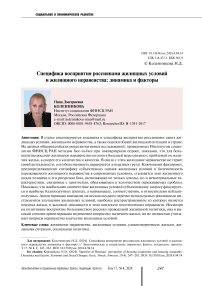Specifics of Russians’ perception of housing conditions and housing inequality: dynamics and factors
Автор: Kolennikova N.D.
Журнал: Economic and Social Changes: Facts, Trends, Forecast @volnc-esc-en
Рубрика: Social and economic development
Статья в выпуске: 4 т.17, 2024 года.
Бесплатный доступ
The paper analyzes the dynamics and specifics of Russians’ perception of their housing conditions, housing inequality, as well as assessments of the overall housing situation in the country. Based on the data of all-Russian representative studies conducted by the Institute of Sociology FCTAS RAS using face-to-face method in the framework of door-to-door surveys, it is shown that for most Russians housing inequality today is more related to the problem of housing quantity and quality, rather than housing availability. In this regard, housing inequality remains a critical issue, and its severity varies for different groups. Key factors determining the specifics of subjective assessments of housing conditions and the acuteness of housing inequality in modern conditions are the stage of a person’s life and their resource base, which includes not only income, but also intangible characteristics related to employment, education and the number of problems an individual has to deal with. It is shown that the greatest match between housing conditions and related subjective demands is recorded in the most prosperous groups, and the greatest mismatch, respectively, in relatively disadvantaged ones. Attention is focused on a very limited list of tools used by Russians to improve housing conditions, the most common of which is the purchase of housing, and the high relevance of settlement inequalities in this context. Although most Russians approve of the state housing policy, it is highly focused on addressing housing issues, but does not fully take into account inequality in the quality of housing conditions.
Housing inequality, housing conditions, housing satisfaction, housing situation, social policy
Короткий адрес: https://sciup.org/147245868
IDR: 147245868 | УДК: 316.472.3 | DOI: 10.15838/esc.2024.4.94.14
Список литературы Specifics of Russians’ perception of housing conditions and housing inequality: dynamics and factors
- Beer A., Faulkner D., Paris C., Clower T. (2011). Housing Transitions through the Life Course: Aspirations, Needs and Policy. Bristol: Bristol University Press.
- Bessonova O.E. (2012). Housing model in the structure of the institutional logic of the transformation matrix. Obshchestvo i ekonomika=Society and Economics, 2, 59–78 (in Russian).
- Bogomolova T.Yu., Cherkashina T.Yu. (2020). The stratification of Russian households by non-financial wealth: Volume, structure and correlates. Mir Rossii=The Universe of Russia, 29(4), 6–33. DOI: 10.17323/1811-038X-2020-29-4-6-33 (in Russian).
- Burdyak A.Ya. (2015). Housing in post-Soviet Russia: Inequality and the problem of generation. Zhurnal issledovaniĭ sotsial'noi politiki=The Journal of Social Policy Studies, 13(2), 273–288 (in Russian).
- Clair A. (2019). Housing: An under-explored influence on children’s well-being and becoming. Child Ind Res, 12, 609–626 DOI: 10.1007/s12187-018-9550-7
- Dewilde C., Ronald R. (2017). Housing Wealth and Welfare. Cheltenham, UK; Northamp¬ton. MA: Edward Elgar Pub.
- Dol K., Boumeester H. (2018). Home ownership under changing labour and housing market conditions: Tenure preferences and outcomes among freelancers and flex workers. International Journal of Housing Policy, 18(3), 355–382. DOI: 10.1080/19491247.2017.1331594
- Forrest R., Izuhara M. (2012). The shaping of housing histories in Shanghai. Housing Studies, 27(1), 27–44. DOI: 10.1080/02673037.2012.629292
- Gorshkov M.K., Tikhonova N.E. (Eds.). (2024). Rossiiskoe obshchestvo i vyzovy vremeni. Kniga sed’maya [Russian Society and the Challenges of Time. Book Seven]. Moscow: Ves’ Mir.
- Green A. (2017). The Crisis for Young People: Generational Inequalities in Education, Work, Housing and Welfare. Cham: Palgrave Macmillan. DOI: 10.1007/978-3-319-58547-5
- Kobyshcha V.V., Novokreshchenov M.V., Shepetina K.Yu. (2022). Housing trajectories. Review of foreign and Russian studies. Monitoring obshchestvennogo mneniya: ekonomicheskie i sotsial’nye peremeny=Monitoring of Public Opinion: Economic and Social Changes, 1, 348–383. DOI: 10.14515/monitoring.2022.1.1857 (in Russian).
- Krotov P.P., Buravoĭ M., Lytkina T.S. (2003). Zhilishchnaya stratifikatsiya goroda: rynochnaya evolyutsiya sovetskoi modeli [Housing Stratification of the City: Market Evolution of the Soviet Model]. Syktyvkar: Komi nauchnyi tsentr UrO RAN.
- Nichols N., Braimoh J. (2018). Community safety, housing precariousness and processes of exclusion: An institutional ethnography from the standpoints of youth in an “unsafe” urban neighbourhood. Critical Sociology, 44(1), 157–172.
- Ptichnikova G.A. (2012). “Unfair city”: Urban space as a reflection of public relations. Sotsiologiya goroda=Urban Sociology, 3, 47–55 (in Russian).
- Ruiz-Tagle J., Urria I. (2022). Household overcrowding trajectories and mental well-being. Social Science & Medicine, 296, 114051. DOI: 10.1016/j.socscimed.2021.114051
- Solari C.D., Mare R.D. (2012). Housing crowding effects on children’s wellbeing. Social Science Research, 41(2), 464–476.
- Starikova M.M. (2015). Housing issue in intergenerational contract. Monitoring obshchestvennogo mneniya: ekonomicheskie i sotsial’nye peremeny=Monitoring of Public Opinion: Economic and Social Changes, 6, 105–117. DOI:10.14515/monitoring.2015.6.06 (in Russian).
- Starikova M.M. (2018). Housing inequality in cities as a form of social stratification: Criteria for distinguishing housing classes and strata. Urbanistika, 3, 71–98. DOI: 10.7256/2310-8673.2018.3.27955 (in Russian).
- Swope C.B., Hernandez D. (2019). Housing as a determinant of health equity: A conceptual model. Social Science Medicine, 243, 112571. DOI: 10.1016/j.socscimed.2019.112571
- Tikhonova N.E. (Ed.). (2018). Model’ dokhodnoi stratifikatsii rossiiskogo obshchestva: dinamika, faktory, mezhstranovye sravneniya [Income Stratification Model of the Russian Society: Dynamics, Factors, Cross-Country Comparisons]. Moscow; Saint Petersburg: Nestor-Istoriya.
- Tikhonova N.E. (Ed.). (2022). Obshchestvo neravnykh vozmozhnostei: sotsial’naya struktura sovremennoi Rossii [Society of Unequal Opportunities: Social Structure of Modern Russia]. Moscow: Ves’ Mir.
- Tikhonova N.E., Akatnova A.M., Sedova N.N. (2007). Housing policy in modern Russia. The situation in providing the population with housing and public utilities. Reforming the housing and utilities sector. Sotsiologicheskie issledovaniya, 1, 1–25 (in Russian).
- Wind B., Hedman L. (2017). The uneven distribution of capital gains in times of socio-spatial inequality: Evidence from Swedish housing pathways between 1995 and 2010. Urban Studies, 55(12), 2721–2742. DOI: 10.1177/0042098017730520
- Zavisca J.R. (2012). Housing the New Russia. Ithaca, London: Cornell University Press.
- Zhu Y., Holden M. (2023). Housing and psychosocial well-being during the COVID-19 pandemic. Habitat International, 135, 102812. DOI: 10.1016/j.habitatint.2023.102812


